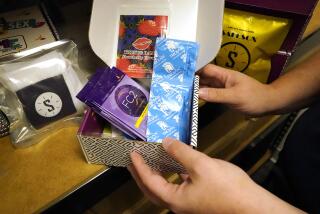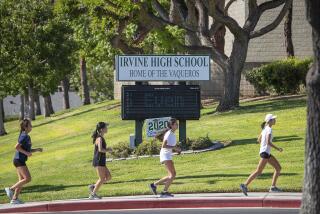HPV vaccine doesn’t make teen girls engage in risky sexual behavior, study shows
Girls who got vaccinated against HPV were more likely than their unvaccinated peers to become infected with a sexually transmitted disease, but the vaccine was definitely not to blame for their risky sexual behavior, according to a new study of more than 200,000 American teens.
Even for girls who didn’t get the HPV vaccine, the risk of being diagnosed with a sexually transmitted infection increased with age, the study authors found. By comparing the changes in infection rates for both groups of girls, the researchers were able to isolate the effect of the vaccine – and they found that it was nonexistent.
“We found no evidence that HPV vaccination leads to higher rates of STIs,” they wrote in a study published Monday in JAMA Internal Medicine.
The vaccine protects adolescent girls and women against the strains of human papillomavirus that cause most cases of cervical cancer. HPV can also cause vaginal, vulvar, anal, penile and oropharynx cancers, which is why the vaccines are recommended for adolescent boys as well as girls.
Two versions of the vaccine – Gardasil and Cervarix – have been endorsed by the Centers for Disease Control and Prevention, though Gardasil fights more strains of HPV and therefore protects against a wider range of cancers, as well as genital warts. Both vaccines require three doses to take full effect, and experts recommend that boys and girls begin the series when they are 11 or 12 years old. That way, they are fully protected before they become sexually active.
However, many parents – and even some doctors – have been reluctant to vaccinate preteens due to fears that it may encourage them to start having sex. Even in cases where teenagers are already sexually active, the vaccine might make them less inclined to use condoms or take other safe-sex precautions if they feel their bodies are already armed against STIs, some worry.
Attitudes like these are largely responsible for the low vaccination rates in the U.S., according to nationwide surveys. In 2013, only 57% of girls between 13 and 17 had even started the HPV vaccine regimen, and only 38% got all three doses.
Various small studies have found no link between vaccination and sexual activity, but the study subjects didn’t reflect the nation as a whole. So a group of researchers from Harvard Medical School and USC examined six years’ worth of insurance claims from around the country to see if they could get more definitive answers.
The researchers identified young women between 12 and 18 who got at least one dose of Gardasil. (Cervarix wasn’t approved until the tail end of the study period.) The three-month period during which they got their first dose was designated the “index quarter,” and the researchers combed through the insurance claims one year before and one year after that quarter to see whether the young women filled any prescriptions for birth control or were treated for any sexually transmitted infections.
For each young woman who got the HPV vaccine, the researchers identified at least one other young woman who was the same age, lived in the same ZIP code and had the same health insurance but didn’t get vaccinated. Their records for the years before and after the index quarter were examined too.
The researchers found that the 21,610 young women who were vaccinated were more likely to have a sexually transmitted infection than the 186,501 young women who weren’t vaccinated. In the year before the index quarter, the STI rate was 1.6 per 1,000 among those who went on to get the vaccine and 0.9 per 1,000 for their matched controls. In the year after the index quarter, those rates were 2.4 and 1.4 per 1,000, respectively.
The study authors weren’t surprised to see the infection rates rise in both groups – the older girls get, the greater their risk of an STI. For the researchers, the real question was whether the infection rate grew faster among girls who were vaccinated than among girls who weren’t. After crunching the numbers, they determined that the increases for both groups were essentially the same.
In further analysis, they looked at younger girls (those between the ages of 12 and 14) separately from older girls (ages 15 through 18). They also ran the numbers just for girls who used prescription birth control. In all of these cases, the increase in STI infection rates were the same for those who were vaccinated and those who weren’t.
“Although vaccinated females had higher STI rates after vaccination compared with matched controls, these differences existed before vaccination as well,” they concluded. “Our findings should be reassuring to physicians, parents, and policy makers that HPV vaccination is unlikely to promote unsafe sexual activity.”
In a commentary that accompanied the study, Emory University epidemiologist Robert Bednarczyk expressed hope that the study findings would help erase “the stigma of HPV vaccine.”
Bednarczyk, an expert on preventing HPV-related cancers, explained that the CDC’s Advisory Committee on Immunization Practices recommends the vaccine for 11- and 12-year-olds for three very good reasons. For starters, the vaccine generates a stronger antibody response in younger kids than older ones. In addition, boys and girls in this age group are already getting the tetanus-diphtheria-acelluar pertussis (Tdap) booster and the MCV4 meningococcal conjugate vaccine, so adding a third vaccine to the list should be more convenient for parents and doctors.
Most importantly, vaccinating preteens vastly increases the odds of protecting them before they start having sex.
“Just as we do not wait until we have been in the sun for two hours to apply sunscreen, we should not wait until after an individual is sexually active to attempt to prevent HPV infection,” he wrote.
For more medical news, follow me on Twitter @LATkarenkaplan and “like” Los Angeles Times Science & Health on Facebook.







